Abstract
Rhizobium japonicum mutant strain HS111 was previously shown to be defective in the rate of initiation of infection leading to subsequent nodule formation (1984 Plant Physiol 74: 84-89). Mutant strain HS111's defect in nodulation can be phenotypically reversed to wild type levels by pretreatment with root exudates from all soybean varieties that have been tested. The data indicate that lectin-Rhizobium interaction is necessary for the phenotypic reversal of the nodulation characteristics of mutant strain HS111. Pretreatment of strain HS111 with soybean seed lectin mimics the effect of root exudate pretreatment. In addition, the presence of 30 millimolar d-galactose, a hapten of soybean seed lectin, in the root exudate or soybean seed lectin pretreatment solution prevents enhancement of nodulation of strain HS111. Pretreatment of mutant strain HS111 in soybean root exudate which has had galactose-specific lectin(s) removed by affinity chromatography (affinity eluate) results in no enhancement of nodulation by strain HS111. Lectin(s) subsequently removed from the affinity column possesses 100% of the stimulatory activity originally found in the root exudate. Pretreatment of strain HS111 in root exudate from a soybean seed line (T102) known to lack seed lectin due to an insertion in the structural gene results in the reversal of the defective nodulation phenotype. This latter result indicates that the lectin found in soybean root exudate is genetically distinct from the seed lectin. It is apparently this root lectin that is involved in nodulation.
Full text
PDF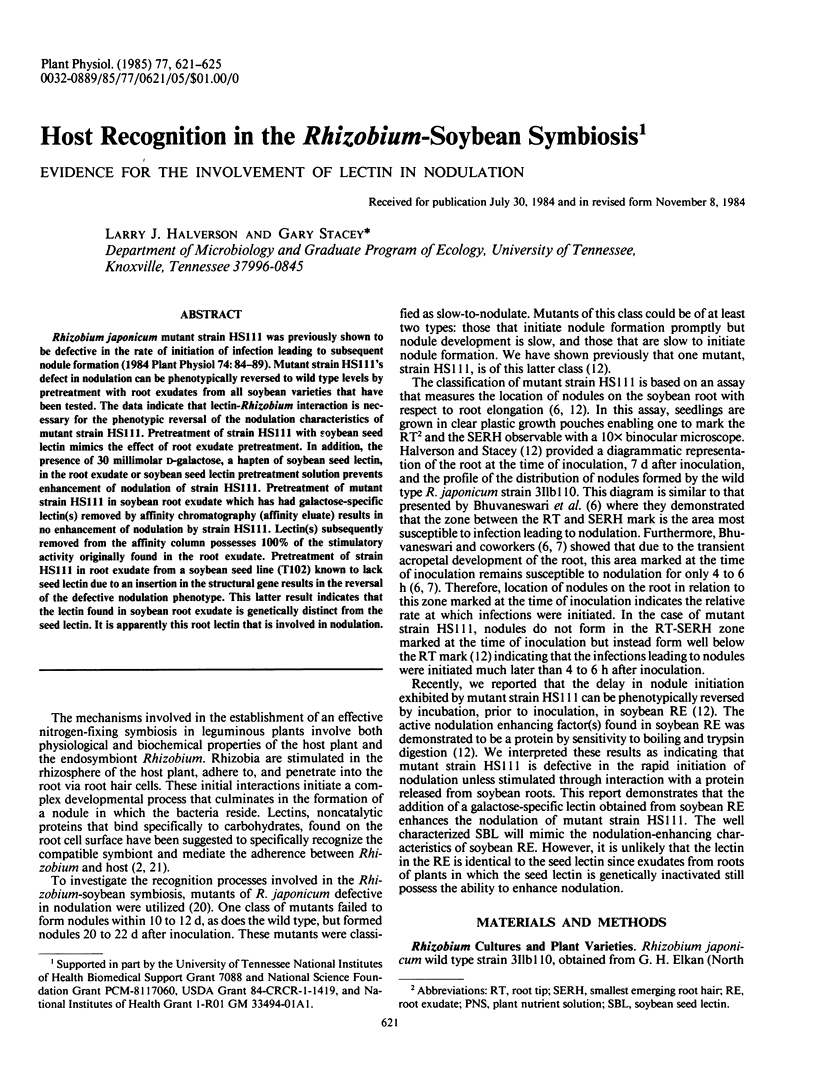
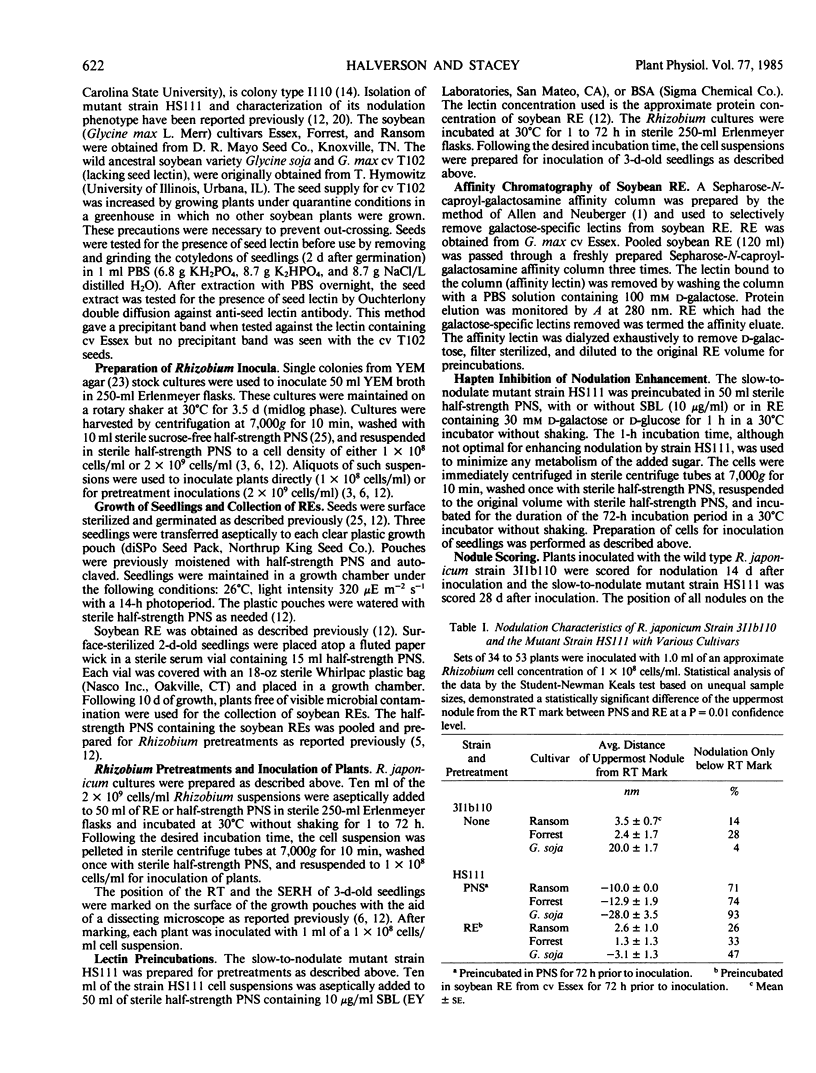
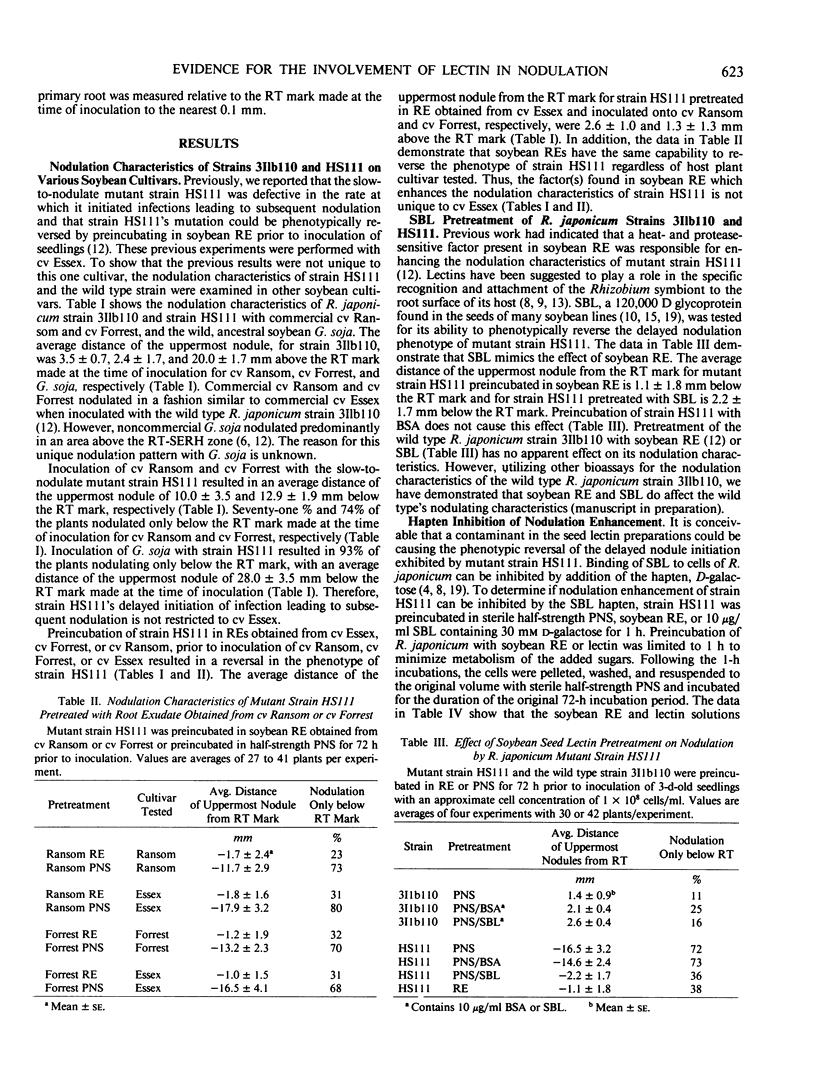
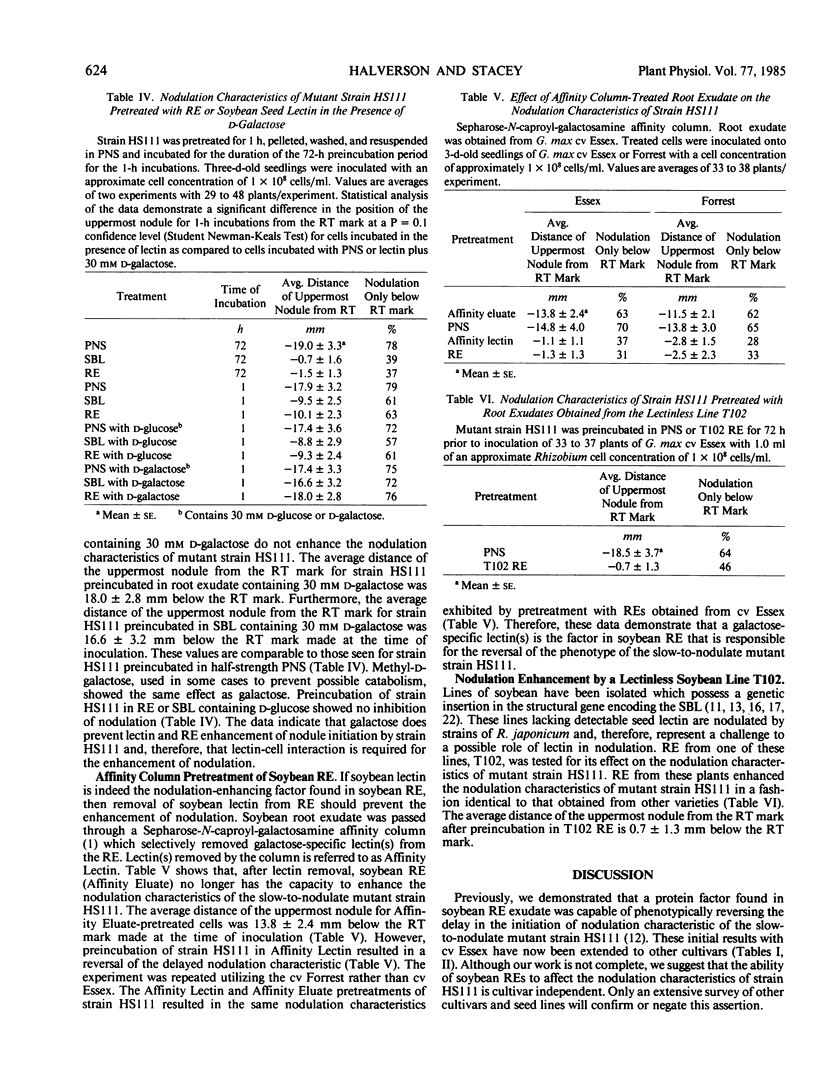
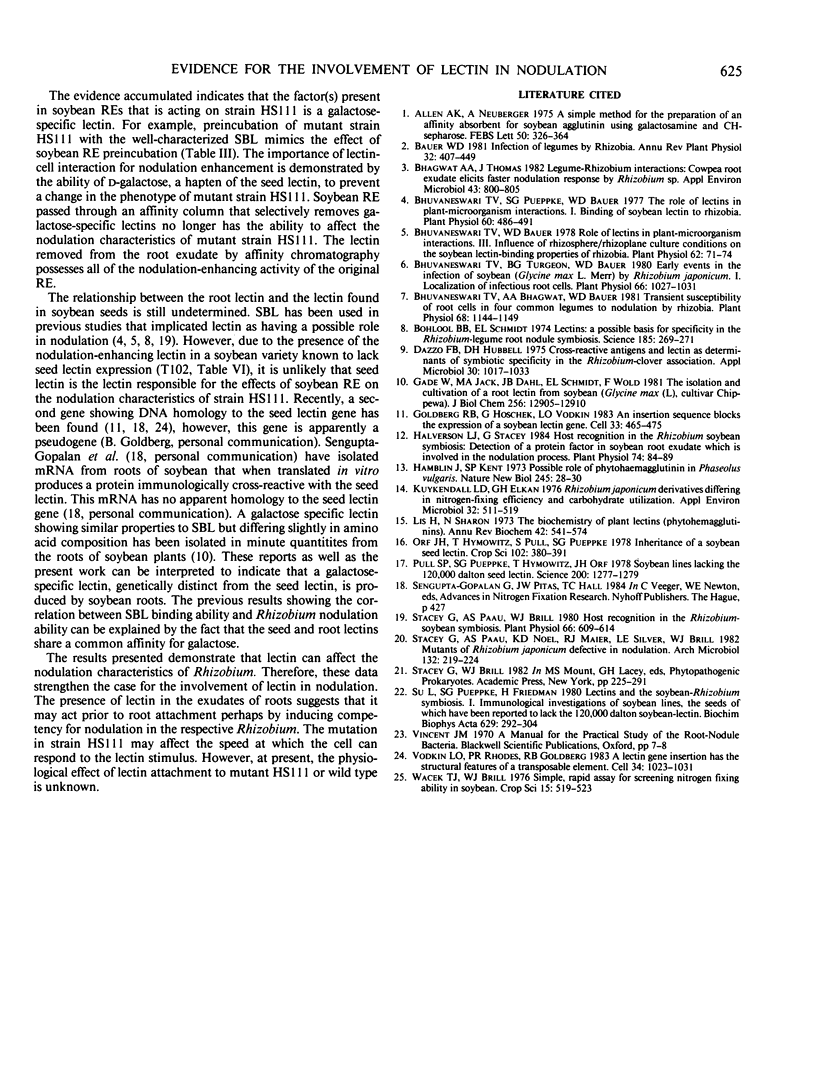
Selected References
These references are in PubMed. This may not be the complete list of references from this article.
- Allen A. K., Neuberger A. A simple method for the preparation of an affinity absorbent for soybean agglutinin using galactosamine and CH-Sepharose. FEBS Lett. 1975 Feb 15;50(3):362–364. doi: 10.1016/0014-5793(75)80528-x. [DOI] [PubMed] [Google Scholar]
- Bhagwat A. A., Thomas J. Legume-Rhizobium interactions: cowpea root exudate elicits faster nodulation response by Rhizobium species. Appl Environ Microbiol. 1982 Apr;43(4):800–805. doi: 10.1128/aem.43.4.800-805.1982. [DOI] [PMC free article] [PubMed] [Google Scholar]
- Bhuvaneswari T. V., Bauer W. D. Role of Lectins in Plant-Microorganism Interactions: III. Influence of Rhizosphere/Rhizoplane Culture Conditions on the Soybean Lectin-binding Properties of Rhizobia. Plant Physiol. 1978 Jul;62(1):71–74. doi: 10.1104/pp.62.1.71. [DOI] [PMC free article] [PubMed] [Google Scholar]
- Bhuvaneswari T. V., Bhagwat A. A., Bauer W. D. Transient susceptibility of root cells in four common legumes to nodulation by rhizobia. Plant Physiol. 1981 Nov;68(5):1144–1149. doi: 10.1104/pp.68.5.1144. [DOI] [PMC free article] [PubMed] [Google Scholar]
- Bhuvaneswari T. V., Pueppke S. G., Bauer W. D. Role of lectins in plant-microorganism interactions: I. Binding of soybean lectin to rhizobia. Plant Physiol. 1977 Oct;60(4):486–491. doi: 10.1104/pp.60.4.486. [DOI] [PMC free article] [PubMed] [Google Scholar]
- Bhuvaneswari T. V., Turgeon B. G., Bauer W. D. Early Events in the Infection of Soybean (Glycine max L. Merr) by Rhizobium japonicum: I. LOCALIZATION OF INFECTIBLE ROOT CELLS. Plant Physiol. 1980 Dec;66(6):1027–1031. doi: 10.1104/pp.66.6.1027. [DOI] [PMC free article] [PubMed] [Google Scholar]
- Bohlool B. B., Schmidt E. L. Lectins: a possible basis for specificity in the Rhizobium--legume root nodule symbiosis. Science. 1974 Jul 19;185(4147):269–271. doi: 10.1126/science.185.4147.269. [DOI] [PubMed] [Google Scholar]
- Dazzo F. B., Hubbell D. H. Cross-reactive antigens and lectin as determinants of symbiotic specificity in the Rhizobium-clover association. Appl Microbiol. 1975 Dec;30(6):1017–1033. doi: 10.1128/am.30.6.1017-1033.1975. [DOI] [PMC free article] [PubMed] [Google Scholar]
- Gade W., Jack M. A., Dahl J. B., Schmidt E. L., Wold F. The isolation and characterization of a root lectin from soybean (Glycine max (L), cultivar Chippewa). J Biol Chem. 1981 Dec 25;256(24):12905–12910. [PubMed] [Google Scholar]
- Goldberg R. B., Hoschek G., Vodkin L. O. An insertion sequence blocks the expression of a soybean lectin gene. Cell. 1983 Jun;33(2):465–475. doi: 10.1016/0092-8674(83)90428-2. [DOI] [PubMed] [Google Scholar]
- Halverson L. J., Stacey G. Host recognition in the Rhizobium-soybean symbiosis: detection of a protein factor in soybean root exudate which is involved in the nodulation process. Plant Physiol. 1984 Jan;74(1):84–89. doi: 10.1104/pp.74.1.84. [DOI] [PMC free article] [PubMed] [Google Scholar]
- Hamblin J., Kent S. P. Possible role of phytohaemagglutinin in Phaseolus vulgaris L. Nat New Biol. 1973 Sep 5;245(140):28–30. doi: 10.1038/newbio245028a0. [DOI] [PubMed] [Google Scholar]
- Kuykendall L. D., Elkan G. H. Rhizobium japonicum derivatives differing in nitrogen-fixing efficiency and carbohydrate utilization. Appl Environ Microbiol. 1976 Oct;32(4):511–519. doi: 10.1128/aem.32.4.511-519.1976. [DOI] [PMC free article] [PubMed] [Google Scholar]
- Lis H., Sharon N. The biochemistry of plant lectins (phytohemagglutinins). Annu Rev Biochem. 1973;42(0):541–574. doi: 10.1146/annurev.bi.42.070173.002545. [DOI] [PubMed] [Google Scholar]
- Pull S. P., Pueppke S. G., Hymowitz T., Orf J. H. Soybean lines lacking the 120,000-dalton seed lectin. Science. 1978 Jun 16;200(4347):1277–1279. doi: 10.1126/science.200.4347.1277. [DOI] [PubMed] [Google Scholar]
- Stacey G., Paau A. S., Brill W. J. Host recognition in the Rhizobium-soybean symbiosis. Plant Physiol. 1980 Oct;66(4):609–614. doi: 10.1104/pp.66.4.609. [DOI] [PMC free article] [PubMed] [Google Scholar]
- Su L. C., Pueppke S. G., Friedman H. P. Lectins and the soybean-Rhizobium symbiosis. I. Immunological investigations of soybean lines, the seeds of which have been reported to lack the 120 000 dalton soybean lectin. Biochim Biophys Acta. 1980 May 7;629(2):292–304. doi: 10.1016/0304-4165(80)90102-6. [DOI] [PubMed] [Google Scholar]
- Vodkin L. O., Rhodes P. R., Goldberg R. B. cA lectin gene insertion has the structural features of a transposable element. Cell. 1983 Oct;34(3):1023–1031. doi: 10.1016/0092-8674(83)90560-3. [DOI] [PubMed] [Google Scholar]


